Learn the Many Advantages of PPC ASIN Targeting & Category Association to Drive Sales
Say you’re a single bachelor and you’re looking for somebody to settle down with. While we don’t normally recommend bars as the go-to place to necessarily meet your soulmate, let’s just say you like to frequent your local watering-hole and often meet women there.
You come in one night and you meet a woman who seems to claim many of your pre-qualifiers – she’s nice looking, has a good job, and gets your terrible jokes. You’re thinking about asking her on a date, but while you are closing out your tab, another woman walks in that you’re just drawn to. She saunters up to the bar and the two of you start chatting. She has a radiant smile, a Ph.D. in childhood psychology, and actually tells funny jokes that counteract your bad ones. You may end up asking her out or you may end up sticking with the original woman you met.
That’s kind of how Amazon sponsored ads product targeting works.
Product Attribute Targeting (or PAT) is a powerful way to increase market share, drive incremental sales, and defend your brand on Amazon. Product Targeting is now a part of Sponsored Products, Sponsored Brands, and Sponsored Display and weaponized as every advertiser’s strategy moving forward.
Streamlined Campaign Creation
Teikametrics streamlines the entire PAT campaign creation process. By using Campaign Creator within the Teikametrics platform, you can avoid the hassle of logging in and out of different platforms. This translates to significant time savings and a smoother workflow, allowing you to focus on optimizing your campaigns and maximizing your advertising ROI.
What is Product Attribute Targeting?
Amazon Product Targeting allows sellers and vendors to claim ad space alongside a specific set of products, brands, or items.
PAT can point at individual ASINs (similar to an exact match in keyword targeting) or at a category target.

For example, let’s say you create a manual Sponsored Product campaign and choose to target an ad group against the brand ‘Acme Industrials’ and against a 4-star review rating of theirs. Now, whenever a shopper on Amazon sees a product from that brand (e.g. in search or in product details) that has a 4-star review, your ads will be allowed to bid for a spot on the page the buyer is viewing. If one of your ads wins the bid, it will show up on the page.
On Which Pages Can My Product Attribute Targeting Ads Show Up?
PAT amazon ads can show up in all the same places that a Sponsored Product ad can.
These places are:
- Search Results
- Product Details
- Add-To-Cart
- Check Out
- Thank You
Sponsored Display Amazon PAT ads can also win the top banner on the product detail page and now can even appear on the front page of Amazon.
To ensure that buyers have a good experience, Amazon controls how many ads for the same product line (i.e. parent ASIN) show up on a given page. If you have an ad that matches the search the user performed via keyword targeting AND another one that matches the search results via PAT, Amazon will likely choose one (probably the highest bid), rather than showing both.
How Do I Build an Amazon PPC Targeting Strategy?
In Amazon product ads management, create a campaign with which to use Product Attribute Targeting and create one ad group for each kind of PAT (ASINs vs. category).
Please note: PAT cannot be used within the same PPC ad group as Amazon keyword targeting. You can, however, have an Amazon ad group with PAT and an ad group with keyword targets within the same campaign. Just make sure your keyword and product negatives are either all at the campaign level, or correctly aligned with their associated ad group.
Amazon product attribute targeting can only be used at the ad group level within manual campaigns – not automatic ones. A given Amazon PAT ad group can either target a basket of ASINs (your own or others’) or a particular category with refinement by brand, price, or reviews.
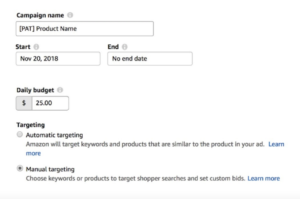
Name your ad group with the kind of PPC Keyword targeting you intend. For example – ‘[PAT] Product Name – ASIN Targeting – B000000.’ For the ad groups, select products from your catalog to advertise and then select ‘Product Targeting’ under the ‘Targeting’ menu.
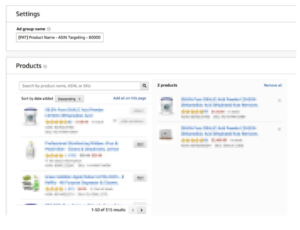
For Amazon Category Targeting:
Select the ‘Categories’ tab of the ‘Product Targeting’ modal. Now, for each one, click the ‘Refine’ option and further target a particular brand, price range, Prime eligibility, or star rating. Keep an eye on the ‘Products Targeted’ count below to make sure you’re not going too narrow or too broad.
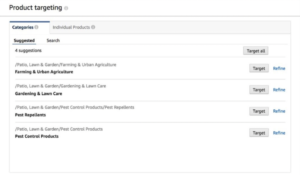
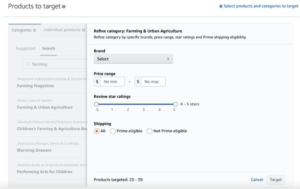
For ASIN Targeting:
Select the ‘Individual Products’ tab of the ‘Product Targeting’ modal. Now either enter a list of ASINs from the Search Term Report (auto campaigns often generate these), or use the ones suggested by Amazon, or search for specific ones yourself. You can also use the Teikametrics Market Intelligence tool to gather the ASINs that are competing with your product for market share.
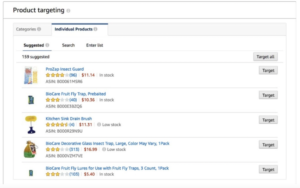
While you can have multiple types of ad groups in a campaign, we recommend keeping category, product, and keyword targeting separated into their own campaigns for control and reporting.
How Do I Read a Search Term Report With PAT?

When you download the search term report to find ASINs from auto campaigns, filter the “Targeting” column by ‘*’ and the “Customer Search Term” column by “b0.” This will capture the ASIN you convert with through auto campaigns.
When you want to look at your category targets and convert them to manual ASIN targets, write the “Targeting” column by “category”. This will help you identify which ASINs are driving sales in your category targeting campaigns (or wasting spend).
What Should Be My Budget for Product Attribute Targeting on Amazon?
There is not just one, overarching answer to this question. However,
We recommend you use a portion of both your brand defense and offense budgets to diversify your spend and sales and use Amazon PAT campaings to grow your business as keyword targeting on Amazon continues to become more competitive. We will discuss each tactic in more detail below.
If I Use PAT, Should I Also Use Competitor Brand Keywords?
Yes, but expect a lower return than targeting your own brand ASIN. Expect similar performance to that of competitor search terms, but keep in mind product relevancy or adjacency when manually choosing ASIN targets.
How Can I Narrow Targeting Using Amazon PAT?
Brand-targeted ad groups can inform you of your competitor’s brand keyword campaigns. In the Search Term Report, these will give you ASINs for competitors against which you’re converting. Look up these ASINs, find the product names, and add those keywords to your brand keyword campaigns.
You can also take note of ASINs against which you are converting poorly, and negate these from brand-targeted ad groups.

When Should I Use Category Targeting vs. ASIN Targeting?
Use category targeting as a way to get broad reach at a higher ACOS. This means you’re going to show up on a lot of searches if you target a popular brand, but you’ll likely have a lower conversion rate. However, this will give your product lots of visibility and will give you a chance to see which specific ASINs within that brand you’re doing well against. It’s a great competitive edge for a new launch.
Use ASIN targeting when your product is disrupting a specific ASIN already on the market, or when you know which ASINs are commonly showing up alongside your product already in search. This is a much narrower reach than targeting a whole brand and should be used for more mature products that understand their competitors.
Strategies for Amazon Ads Targeting
Here are some methods you can implement to use for best Amazon PAT practices.
1. Capture Market Share
The most obvious use of PAT is to attack your competitors and capture market share from them. If you have a clear picture of which brands or products are being considered against your own, advertise against them to see how you fare.
Do your competitive research before you use this strategy. Look through the Search Term Report for ASINs from your auto-campaigns against which you are converting. Think twice about competing with products and brands with much better ratings and/or lower prices. You are likely to pay for browser behavior that never converts. On the flip side, find badly ranked or expensive competitors and attack them.
You can also use category targeting to find similar or adjacent products to target, then move them over to manual product targets once you achieve sales volume.
2. Defend Your Market Share
The adverse side to this strategy is that your competitors will use PAT practices to target you.
When advertising on your own ASINs and brands, consider constructing campaigns that advertise products that sell well with the advertised product. For example, if you have a face washing cream that performs well, target that with your facial moisturizer.
Also, when advertising on your own ASINs, don’t steal a sale from a high-margin product by advertising a similar, lower-margin product against it.
The balance of profitability and product compatibility will vary based on your brand and needs, but make sure your brand defense strategy incorporates or considers both.
3. Brand or Product Launch
When launching something new, it’s hard to predict what keywords are going to work best, but you do not want to waste precious time figuring this out – you need sales now! Use Amazon Product Attribute Targeting to target similar products or brands and ride their searches. This will give you immediate reach with people looking for similar products you are trying to sell. This is particularly powerful if your product is disrupting something already on the market.
For example, if you have just invented a better mousetrap, and want to create a powerful amazon launch strategy, it makes sense to target the brand with the top-selling mouse trap!
Again, consider carefully the quality of your product and do your research. You do not want to target a luxury brand if you’re selling a mass-market product.
4. Opportunistic Advertising
If a brand in your category gets hot off social media, ride the wave! Target them and their products to benefit from the search boost they are getting. This strategy can also be used with their competitor brand keywords.
Conclusion
Back to the two women at the bar … let’s say you were the second woman that just strolled in and you wanted to compete for this man’s attention. You wouldn’t just run away and hide in the bathroom. That wouldn’t be a successful strategy. Instead, you would present yourself in a way that put you in a better light and gave you a competitive edge than the other woman.
After all, that’s what advertising is all about! Also explore the different post about what is Amazon Live!

